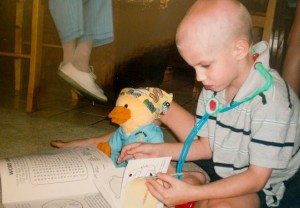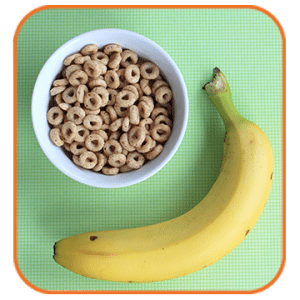Soon after her son was diagnosed with a brain cancer called anaplastic ependymoma, Lisa DeYoung was scanning through a brain tumor foundation website and stumbled upon Chemo Duck.
She had no idea that Chemo Duck existed and is so glad she purchased one for her then 3 year old son.
The comfort and connection Chemo Duck brought to Jack was enormous, she said.

“He had lots of toys and things to play with and distract him, but none of them was like him,” said DeYoung. “I wanted to get him something that he could identify with and looked like him. It turned out to be one of the best things ever.”
Athough Jack, now 8 years old, is no longer in treatment, Chemo Duck is still close by.
“He had Chemo Duck with him the whole time we were in the hospital and when we had appointments,” she recalled. “Through the years he just got very attached to him. He still sleeps with him.”
The bright yellow stuffed animal not only served as an educational tool during his treatments, but became so much more.
“Chemo Duck is important for kids like Jack who are going through a lot of scary and new things,” said his mom. “Being able to show Jack and kids like him what is going to happen really helps allay their fears. He is an invaluable teaching tool and a source of comfort for kids going through cancer treatments.”
Each duck comes outfitted with a catheter sewn into its chest to resemble the line that is central to a chemotherapy patient’s treatment. Jack’s Chemo Duck has an additional resemblance – an incision to match that of his owner.
For the DeYoungs, it helped their son to be able to interact with something that was very similar to himself.
“Chemo Duck was the only toy he had that could be just like him,” she explained. “He was able to play with Chemo Duck in ways he couldn’t play with his other toys and he would hook up a feeding tube to him.”


 During cancer treatment, a child’s appetite is so intermittent and unpredictable that it seems like food and eating become a minefield for parents to navigate. For the next few months, we are partnering with Melissa Sharp from Another Lunch to offer options and ideas to families living with this challenge. Her flair for nutrition and making food fun makes her the perfect fit for the series. Although the collaboration was conceived to assist children living with cancer, these ideas and recipes translate to any number of situations and illnesses that affect appetite. The topics for the series will include how to best add calories, encourage eating, reduce nausea, and ease sore mouths.
During cancer treatment, a child’s appetite is so intermittent and unpredictable that it seems like food and eating become a minefield for parents to navigate. For the next few months, we are partnering with Melissa Sharp from Another Lunch to offer options and ideas to families living with this challenge. Her flair for nutrition and making food fun makes her the perfect fit for the series. Although the collaboration was conceived to assist children living with cancer, these ideas and recipes translate to any number of situations and illnesses that affect appetite. The topics for the series will include how to best add calories, encourage eating, reduce nausea, and ease sore mouths.